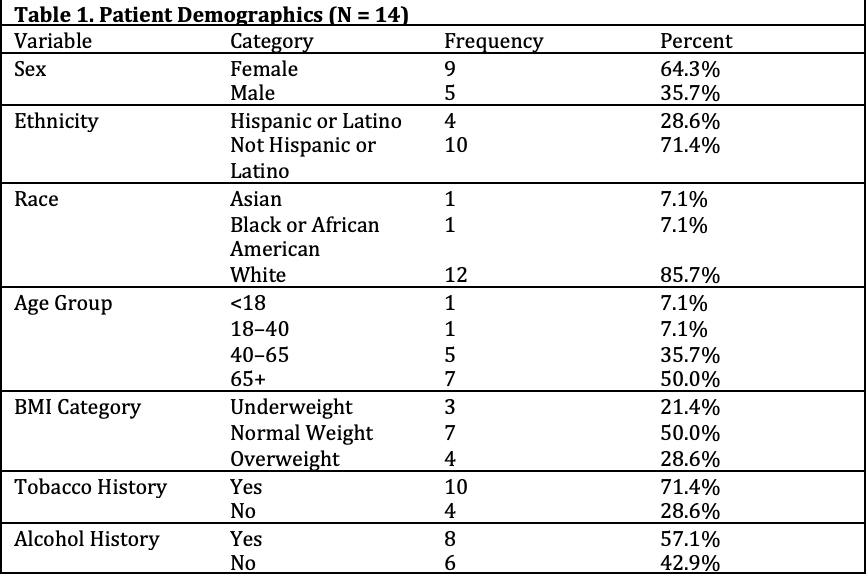Sunday Poster Session
Category: Biliary/Pancreas
P0030 - Outcomes of Gastroenterologist Directed ESWL for Pancreatic Duct Stones - A Study at a Single Academic Tertiary Care Referral Center
Sunday, October 26, 2025
3:30 PM - 7:00 PM PDT
Location: Exhibit Hall

Daniel Nyancho, MD, BS (he/him/his)
University of Texas Health San Antonio
Cleveland, OH
Presenting Author(s)
Daniel Nyancho, MD, BS1, Keerthi Thallapureddy, MD2, Sherif Ibrahim, MD3, Sandeep Patel, DO4, Pavlos Kaimakliotis, MBBS5, Hari Sayana, MD6
1University of Texas Health San Antonio, Cleveland, OH; 2University of Texas Health San Antonio, Temple, TX; 3Medical University of South Carolina, San Antonio, TX; 4University Health System, San Antonio TX, San Antonio, TX; 5University Hospital, San Antonio, TX; 6University of Texas Health San Antonio, San Antonio, TX
Introduction: Extracorporeal shock wave lithotripsy (ESWL) for pancreatic duct (PD) stones is commonly performed by Urologists. Although peroral pancreatoscopy-guided lithotripsy is common, Gastroenterologist (GI)-directed ESWL is growing. The goal of this study is to analyze the outcomes of ESWL at a single academic tertiary care referral center.
Methods: This is a retrospective cohort study of adult patients who have undergone ESWL procedure by an advanced endoscopist for PD stones who were deemed to be unsuccessful or failed endoscopic lithotripsy between Dec 2021 to Oct 2024. Patients were identified by query of ICD-10 codes for ESWL procedure. All the patients underwent ERCP following ESWL procedure. Patients who met the inclusion criteria were included in the study. Demographic information, medical comorbidities, imaging, number of ESWL procedures performed, details of the ESWL procedure and outcomes were collected. STATA.BE was used for statistical analysis.
Results: A total of 14 patients met the inclusion criteria, 64% were female (n = 9). The majority were non-Hispanic (71%, n = 10) and White (85%, n = 12). A total of 71% (n=10) had a history of smoking and 57.1% (n=8) had a history of alcohol use. A total of 28 ESWL procedures were performed, with ESWL was technically successful in 86% of patient (n= 12) and treatment failure and alternative treatment observed in two patients. Prior PD stent placement was seen in 71.23% (n=10) of patients. Post-ESWL pancreatitis occurred in 21% of patients (n = 3) and failed post-ESWL stent placement in 2. Improvement in pain was observed in 57.1% of patients (n = 8), while 64% (n = 9) did not experience recurrence of PD stones within 6 months. Hospital readmission within 6 months was required for 57% of patients (n = 8) with no deaths during this period. At one-year follow-up, 28.6% of patients (n = 4) experienced recurrence of PD stones, and one patient died from cardiac complications unrelated to ESWL procedure.
Discussion: GI-directed ESWL of PD stones in this study demonstrated substantial effectiveness in pain relief, decreased stone recurrence, and morbidity outcomes. Over half of the patients in this study experienced pain resolution—an outcome that may not have been achievable without access to ESWL and concomitant ERCP to remove residual stone burden. ESWL has limitations, including the need for specialized equipment, training, and expertise. Future prospective studies are warranted to better define patient selection criteria and optimize outcomes.

Figure: Summary Statistics of Patient Demographic Information
Disclosures:
Daniel Nyancho indicated no relevant financial relationships.
Keerthi Thallapureddy indicated no relevant financial relationships.
Sherif Ibrahim indicated no relevant financial relationships.
Sandeep Patel indicated no relevant financial relationships.
Pavlos Kaimakliotis indicated no relevant financial relationships.
Hari Sayana: Boston Scientific – Consultant.
Daniel Nyancho, MD, BS1, Keerthi Thallapureddy, MD2, Sherif Ibrahim, MD3, Sandeep Patel, DO4, Pavlos Kaimakliotis, MBBS5, Hari Sayana, MD6. P0030 - Outcomes of Gastroenterologist Directed ESWL for Pancreatic Duct Stones - A Study at a Single Academic Tertiary Care Referral Center, ACG 2025 Annual Scientific Meeting Abstracts. Phoenix, AZ: American College of Gastroenterology.
1University of Texas Health San Antonio, Cleveland, OH; 2University of Texas Health San Antonio, Temple, TX; 3Medical University of South Carolina, San Antonio, TX; 4University Health System, San Antonio TX, San Antonio, TX; 5University Hospital, San Antonio, TX; 6University of Texas Health San Antonio, San Antonio, TX
Introduction: Extracorporeal shock wave lithotripsy (ESWL) for pancreatic duct (PD) stones is commonly performed by Urologists. Although peroral pancreatoscopy-guided lithotripsy is common, Gastroenterologist (GI)-directed ESWL is growing. The goal of this study is to analyze the outcomes of ESWL at a single academic tertiary care referral center.
Methods: This is a retrospective cohort study of adult patients who have undergone ESWL procedure by an advanced endoscopist for PD stones who were deemed to be unsuccessful or failed endoscopic lithotripsy between Dec 2021 to Oct 2024. Patients were identified by query of ICD-10 codes for ESWL procedure. All the patients underwent ERCP following ESWL procedure. Patients who met the inclusion criteria were included in the study. Demographic information, medical comorbidities, imaging, number of ESWL procedures performed, details of the ESWL procedure and outcomes were collected. STATA.BE was used for statistical analysis.
Results: A total of 14 patients met the inclusion criteria, 64% were female (n = 9). The majority were non-Hispanic (71%, n = 10) and White (85%, n = 12). A total of 71% (n=10) had a history of smoking and 57.1% (n=8) had a history of alcohol use. A total of 28 ESWL procedures were performed, with ESWL was technically successful in 86% of patient (n= 12) and treatment failure and alternative treatment observed in two patients. Prior PD stent placement was seen in 71.23% (n=10) of patients. Post-ESWL pancreatitis occurred in 21% of patients (n = 3) and failed post-ESWL stent placement in 2. Improvement in pain was observed in 57.1% of patients (n = 8), while 64% (n = 9) did not experience recurrence of PD stones within 6 months. Hospital readmission within 6 months was required for 57% of patients (n = 8) with no deaths during this period. At one-year follow-up, 28.6% of patients (n = 4) experienced recurrence of PD stones, and one patient died from cardiac complications unrelated to ESWL procedure.
Discussion: GI-directed ESWL of PD stones in this study demonstrated substantial effectiveness in pain relief, decreased stone recurrence, and morbidity outcomes. Over half of the patients in this study experienced pain resolution—an outcome that may not have been achievable without access to ESWL and concomitant ERCP to remove residual stone burden. ESWL has limitations, including the need for specialized equipment, training, and expertise. Future prospective studies are warranted to better define patient selection criteria and optimize outcomes.

Figure: Summary Statistics of Patient Demographic Information
Disclosures:
Daniel Nyancho indicated no relevant financial relationships.
Keerthi Thallapureddy indicated no relevant financial relationships.
Sherif Ibrahim indicated no relevant financial relationships.
Sandeep Patel indicated no relevant financial relationships.
Pavlos Kaimakliotis indicated no relevant financial relationships.
Hari Sayana: Boston Scientific – Consultant.
Daniel Nyancho, MD, BS1, Keerthi Thallapureddy, MD2, Sherif Ibrahim, MD3, Sandeep Patel, DO4, Pavlos Kaimakliotis, MBBS5, Hari Sayana, MD6. P0030 - Outcomes of Gastroenterologist Directed ESWL for Pancreatic Duct Stones - A Study at a Single Academic Tertiary Care Referral Center, ACG 2025 Annual Scientific Meeting Abstracts. Phoenix, AZ: American College of Gastroenterology.
